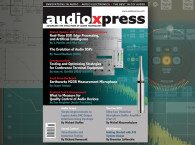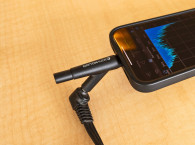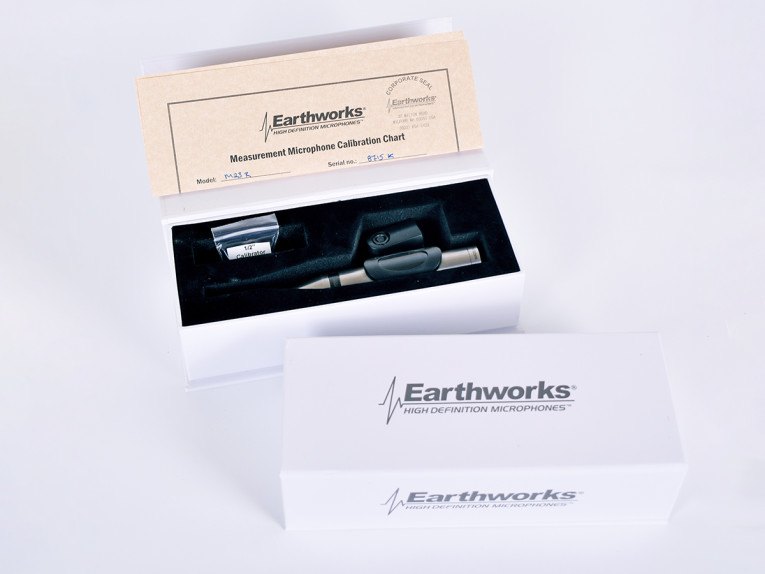
With the burgeoning of easy-to-use and powerful acoustic measurement software, inexpensive measurement microphones have become wildly popular. The proliferation of electret capsules used in other applications (e.g., smart speakers and home automation) has caused the prices to go down, and quality and consistency to go up.
The typical inexpensive mic will have a batch-calibrated electret capsule, a simple source-follower interface, and a single-ended or USB output. And for much of their usage, they’re more than adequate. However, they have clear limitations — dynamic range, noise floor, consistency from unit to unit, stability over time and environmental conditions, and distortion will not be inspiring. They are good enough to get some basic speaker and room measurements, but beyond that, one has to invest in a better mic.
Traditionally, high-quality instrumentation-grade measurement mics have been condenser types requiring polarization and having analog balanced outputs. And expensive — a good lab mic will typically run in the $1,000 to 3,000 range. In the past few years though, small labs, studios, live recordists, sound reinforcement engineers, and serious hobbyists have been offered electret-capsule mics of better quality construction, higher dynamic range interfacing, and individual calibration for intermediate prices between the popular cheapies (e.g., miniDSP’s UMIK) and lab-grade condensers.
For $300 to $600, one can get an electret-based mic with relatively low distortion and individual calibration that meets IEC 61672 Class 1 frequency response conformance at room temperature when used with the calibration file. These “intermediate class” electret-based mics use phantom power (typically 48 V) and have professional XLR outputs, so they require a mic preamp to accommodate them as if they were condensers. Examples include the Earthworks M30 and iSEMcon’s EMX-7150, the latter of which I routinely use for speaker measurement. PCB Piezotronics offers the 130-series array mics, which are likewise excellent, but they use an ICP interface (current source), which is more common in the test and instrumentation world than in audio. The Earthworks M23R is the latest entry in this intermediate market segment (see Photo 1).
Just to put things in context, Earthworks was started by David Blackmer as a measurement microphone company back in the late 1990s before branching out to other markets, developing proprietary acoustics and electronics technology. Blackmer’s goal was to produce the most accurate measurement microphones in the market, since he felt that most of the then existing products did not give reliable results.
To this end, Earthworks has assembled a line of products, all of which have in common attention to time domain response, full individual acoustic calibration, and rugged mechanical design to survive portable and touring use.
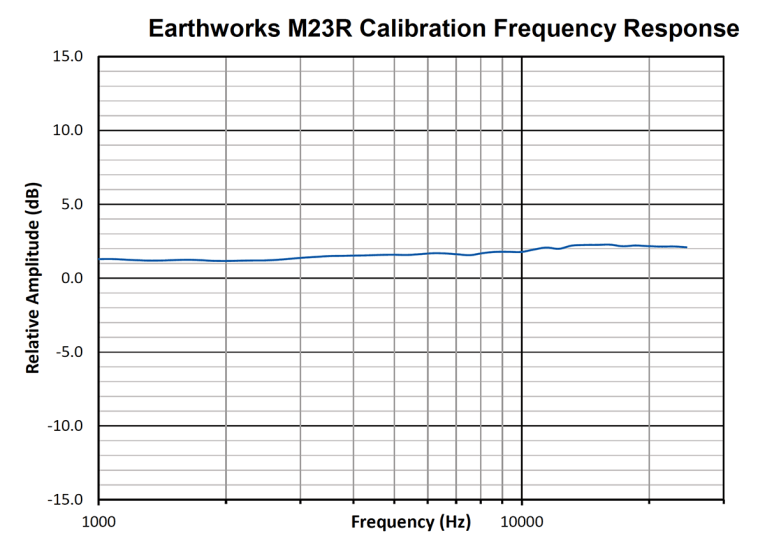
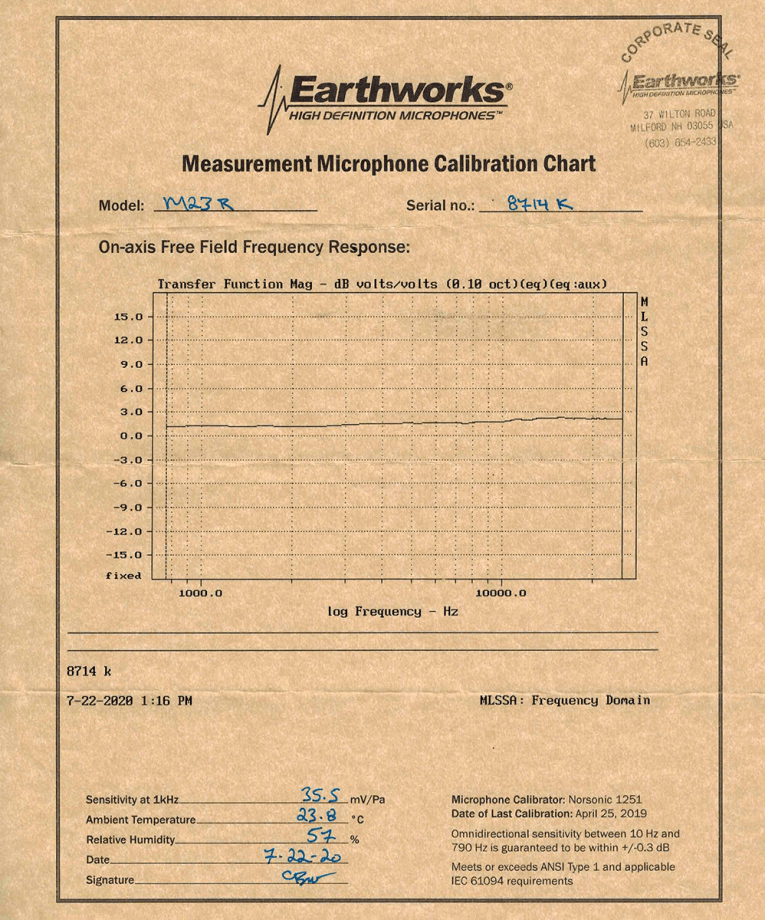
The Product
So what differentiates this product from the other excellent offerings in its price range? There are two things that stand out. First, the M23R has an IEC 61672 Class 1 frequency response before applying equalization. Hence, for most purposes, a calibration file is not needed and the frequency response will be flat enough for measuring room acoustics, machine noises, front-of-house (FOH) sound checks, and even loudspeaker measurement.
If your application requires even tighter frequency response conformance, Earthworks offers the user a digital calibration file in CSV text format, which can be imported into most measurement software. This file is delivered via email to any requesting user after the product is registered.
Figure 1 shows the provided frequency response of the mic tested in my lab, obtained by measuring a driver on a large baffle. It is indeed quite flat in response, comfortably threading a 1 dB needle. Before any correction, is already better than the corrected response of most inexpensive test mics and easily meets Class 1 standards.
The second interesting feature is that the mics can be pre-matched on request—not by the usual method of selecting two or more mics out of a lot with relatively close responses, but using a bit more elegant and versatile method. As with most electret mics, a field-effect transform (FET)-based amplifier is built in but will not be optimal for the lowest possible distortion, noise, and the highest dynamic range. The usual circuit is a simple source follower, which works reasonably well but will not be optimal for lowest possible distortion, noise, and dynamic range.
More sophisticated circuits can be employed to improve an electret mic in all of these areas. Several examples are given in the Scott Wurcer articles listed in Resources. Earthworks uses a circuit similar to one of Wurcer’s. Because of the use of a more sophisticated circuit than a simple follower, Earthworks can match mics for frequency response and sensitivity using some simple RC trimming of the electronics.
Because of this ease of adjustment, Earthworks can do something unique with the M23R. If you want to purchase a mic that is matched to one you already have for sensitivity and frequency response, Earthworks can trim a new mic to match the older one if you provide them the serial number. No need to buy matched pairs from the get-go. And of course, with this matching flexibility, you’re not limited to pairs. If you want to build up, say, a tetrahedral array for Ambisonics or a 16 mic planar array for acoustic holography, every mic can be tightly matched to the others.
One other interesting feature is the mic’s sensitivity. Most 1/4” electret or condenser mics I have used have sensitivities well under 10 mV/Pa. For example, the iSEMcon mic mentioned earlier has a sensitivity of 6 to 7 mV/94 dB. This makes the noise requirements of the following mic preamp quite critical. The M23R has a nominal sensitivity of 36 mV/Pa, more typical of mics with larger diameter diaphragms. This higher sensitivity translates to a lower noise floor from the microphone, as well as effectively dropping the mic preamp’s noise contribution by 20 dB or so.
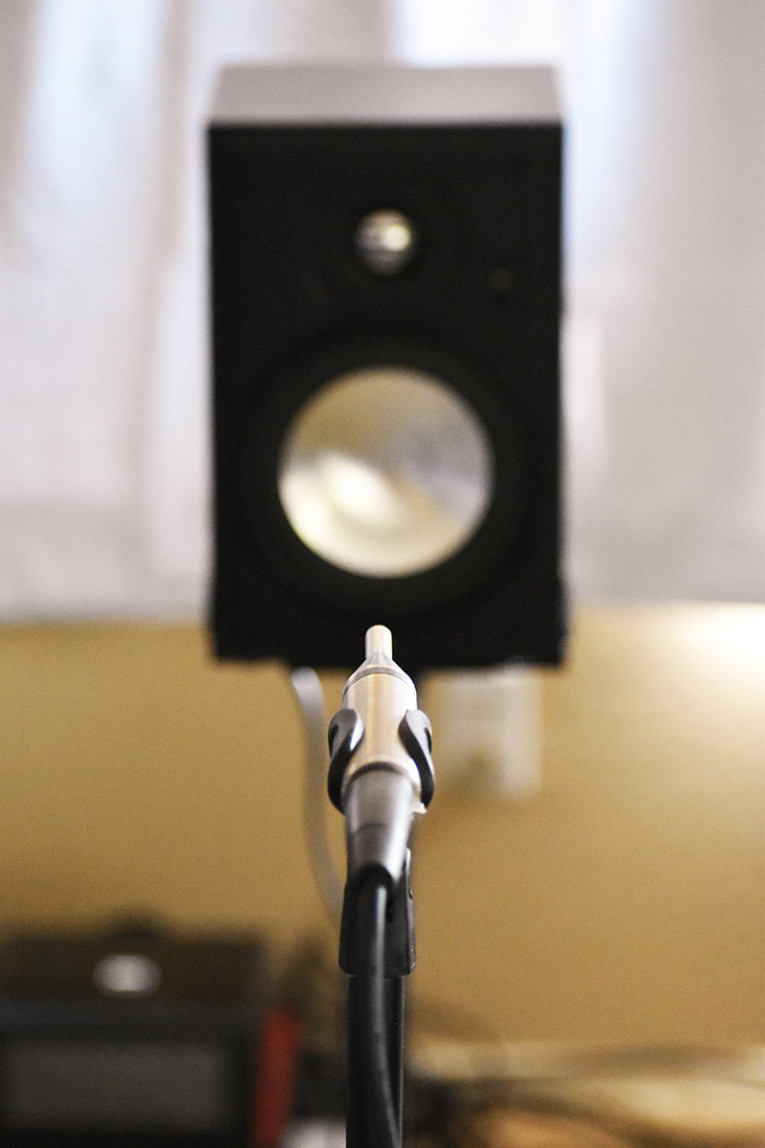
The M23R in the Lab
The M23R arrived packed with calibration data (see Figure 2), a mic clip, and an adapter for attaching the mic to a standard 1/2” calibrator (as shown in Photo 1). The mic case’s form factor is consistent with other Earthworks 1/4” mics: a smooth tapered contour between the capsule and the preamp, minimizing diffraction artifacts.
I began with some basic measurements. As usual, my measurement system comprised an Audio Precision APx525 with an Audio Precision (AP) APx1701 acoustic interface. Reference mics included the PCB Piezotronics 376A31 1/4” and 376A32 1/2” phantom power lab mics and the iSEMcon EMX-7150 electret mic, all with calibration files loaded into the APx525’s software.
First, I checked the sensitivity. The provided calibration sheet listed it as 35.5 mV/Pa. Unfortunately, I no longer have a NIST-traceable SPL calibrator, but the substitution method gives nearly the same accuracy if performed carefully. The reference mic (in this case, the PCB 376A31) was set up approximately 1 m from a small monitor speaker. I played a 1kHz sine wave adjusted to 85dB SPL shown on the AP Monitor/Meter panel. The capsule position was measured with respect to the mic clip, then the PCB mic was replaced in the clip with the M23R positioned so that the capsule was in the same spot that was used for the reference measurement (see Photo 2). The rated sensitivity was 35.5 mV/Pa, and my measurement indicated 35.8 mV/Pa (about 0.07 dB hotter), which was well within both measurement error limits and environmental variables.
Next, I checked the mic's self-noise. My noise measurements are performed by wrapping the mic in a plastic bag, sealing the bag by wrapping completely with duct tape, and burying the mummy in about 200 lbs. of a mixture of cat litter and sand (the BLANK chamber). The baseline noise from this method over a 22 kHz bandwidth, A-weighted, unwindowed (or rectangular window), is under 5 dB SPL. The M23 showed a self-noise under those conditions of 19.6 dB-A. Although this was not an extremely low number in an absolute sense, it was quieter than any other 1/4” mic I have had in my lab and slightly better than Earthworks’ 20dB-A spec. It was certainly quiet enough for typical mike positions in studios.
The M23R’s frequency response was then measured versus the equalized 376A31 reference mic via the substitution method described above, with the M23R’s calibration file loaded into the AP.
The test signal was a swept sine wave (Farina chirp), which was converted in software to the source’s impulse response. The measured impulse response was then gated to remove room reflections, and windowed (AP Equi-ripple) before performing an FFT. The two equalized quasi-anechoic responses, reference and M23R, were then ratioed to derive the M23 on-axis response with respect to the equalized reference. Because of the gating at about 4 ms, the response was only valid above about 250 Hz, but generally, microphone response variations for electret capsules are pretty small at low frequencies.

The response from 400 Hz to 20 kHz is shown in Figure 3 and was quite flat, well within 0.1 dB of perfect; any deviations were well within measurement variability. The slight ripple in the response above about 4 kHz may be from a minor reflection from the mic stand, since I did not use one of the long tube adapters common in calibration labs nor did I put foam between the capsule and the mic clip. At any rate, this was excellent performance when compared to the reference, a much more expensive lab-grade metal diaphragm mic.
Next, I measured the distortion as a function of SPL. In order to get high SPL signals, one nice trick is to find a low distortion high output midrange driver with a concave or flat cone profile, then bring the mic to within a few millimeters of the surface (see Photo 3). A frequency should be chosen that is high enough to avoid large excursions but low enough for the driver to still be pistonic. For the particular driver I’ve been using for this duty, 400 Hz to 1,000 Hz seem to work well. This near-field method has the further advantage of the direct signal overwhelming any room noise or reflections.
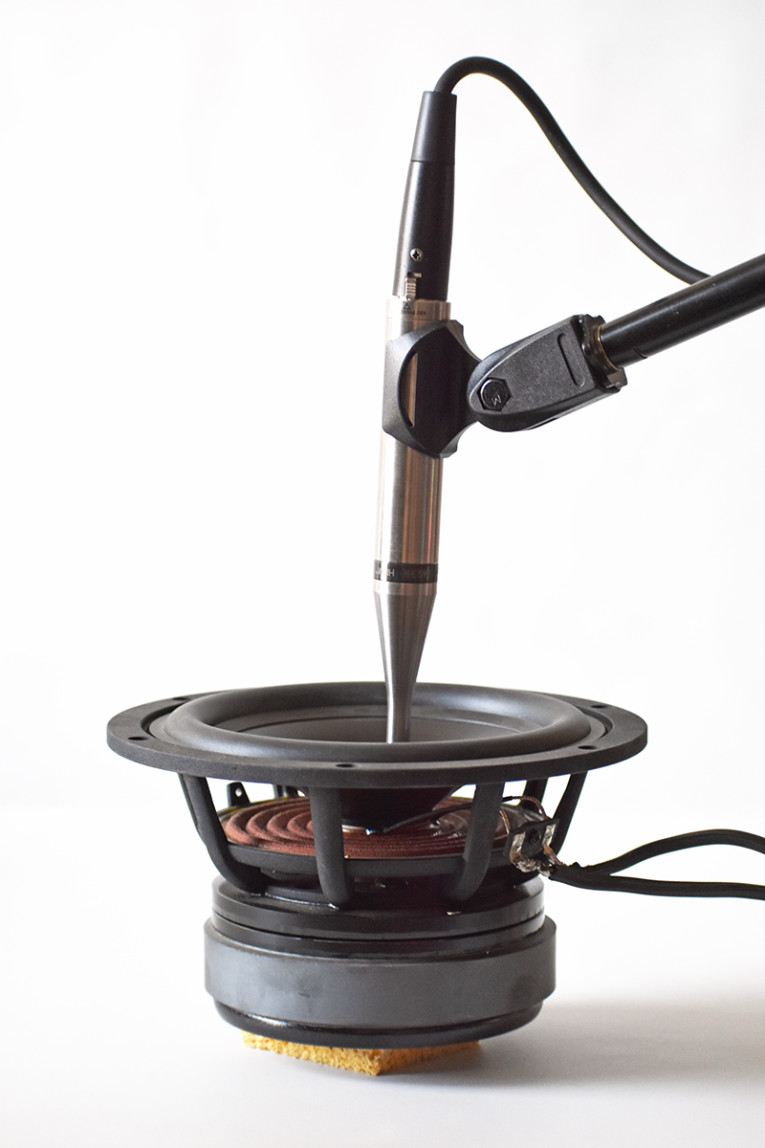
For this THD measurement, I placed the driver face-up on a work surface and isolate it with a chunk of open-cell foam. The driver was connected to the APx1701 and driven with a 1 kHz sine wave up to the point where my personal tolerance hit its Xmax. My results up to that 130 dB SPL point are shown in Figure 4. As a baseline, driver distortion was well under 0.1% at this frequency and level in the nearfield. The decently low distortion from the mic was just beginning to rise at the end, and if extrapolated, would be comfortably under 3% at 140dB SPL. This is a tribute to the design of the electronics.
One of the advantages of a small diameter capsule like this is that it’s easier to achieve a good omnidirectional polar pattern. To measure this, you can use a very nice software driven carousel, which will automate the process and get great angular resolution. Lacking that, you can do the Impecunious Experimenter method of marking angles on a Lazy Susan, then placing the mic stand on it so that the mic capsule is vertically aligned with the rotation axis.
I measured gated frequency response at 30° angular increments, with each measurement being a power average between three measurements at roughly ±4° about the nominal angle plus the nominal (e.g., the 30° measurement is a power average of about 24°, 30°, and 34°). The resulting data at the spot frequencies of 1 kHz, 5 kHz, 10 kHz, and 16 kHz were then transferred to a conventional polar pattern plot (see Figure 5). Note that I used a more expanded radial axis scale than usual, so take this into account when comparing to polar patterns of competitive mics. The M23R really held up well to the sides, being only -2 dB down at 10 kHz and -5 dB down at 16 kHz for a 90° incidence.
At the rear of the mic, we started to see some interference effects from the mic cable at the upper two test frequencies (10 kHz and 16 kHz), so take the absolute numbers at 180° with a grain of salt. But qualitatively, they are a good indicator.
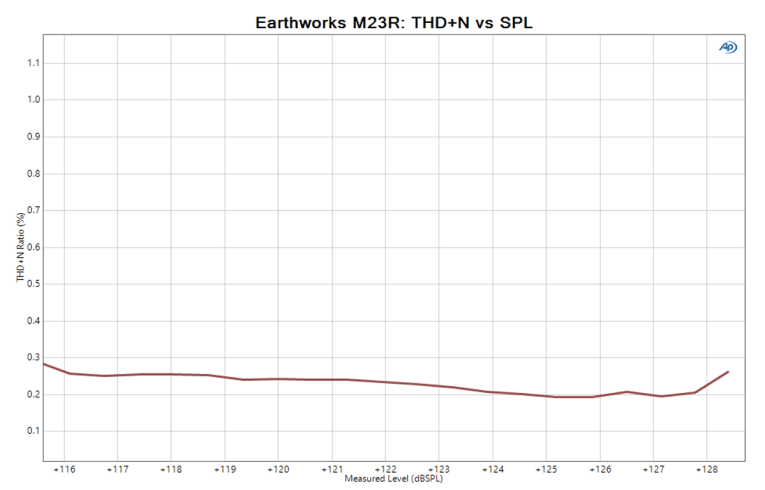
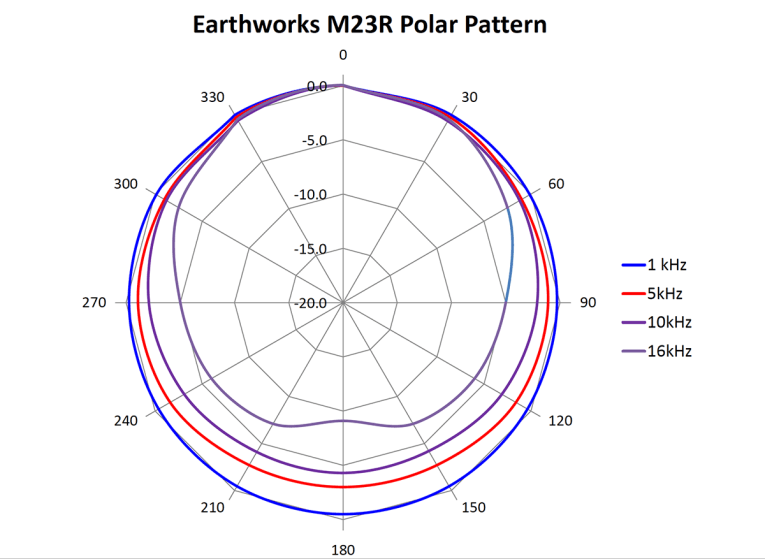
Summing Up
It’s always a delight to get a product to test that isn’t quirky, does exactly what it claims, and has a clear purpose in life. The M23R performed well in all of the basics: accurate and flat response, good polar pattern, low distortion, and for its size, very low noise and high output. In all of these measures, it performed about on a par with the similarly priced Earthworks M30, though it is not specified to the same bandwidth — I strongly suspect that the guts of the two models are the same, with just a few bits rearranged in the electronics.
Comparing the M23R to the M30, what you get here is something that has flatter frequency response in the audible band right out of the box, conforming to IEC 61672 Class 1 without further equalization. It can be put into pairs or arbitrarily sized arrays with tight matching, even if new mics are bought later on to expand the array. aX
Author’s Acknowledgements: Megan Clifford and Taoufiq Bellaime of Earthworks really went above and beyond in helping me out, being patient with my less intelligent questions, thorough in their explanations, and working me through problems I ran into along the way.
This article was originally published in audioXpress, November 2020.
Resources
www.earthworksaudio.com
A. Khenkin, “How Earthworks Measures Microphones,” Earthworks Audio, www.earthworksaudio.com/wp-content/uploads/2012/07/how-earthworks-measures-mics.pdf.
C. Walber, “Acoustic Methods of Microphone Calibration,” Voice Coil, September 2017, https://audioxpress.com/article/acoustic-methods-of-microphone-calibration.
S. Wurcer, “Low Noise Microphone Preamplifiers,” Part 1, Linear Audio, Volume 1, www.linearaudio.net.
S. Wurcer, “Low Noise Microphone Preamplifiers,” Part 2, Linear Audio, Volume 3, www.linearaudio.net.




